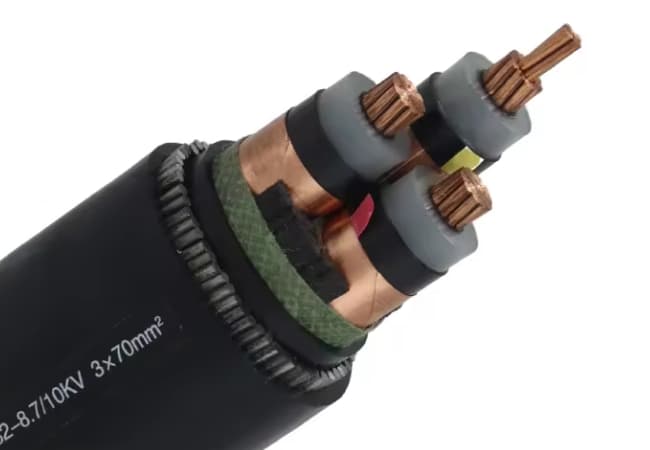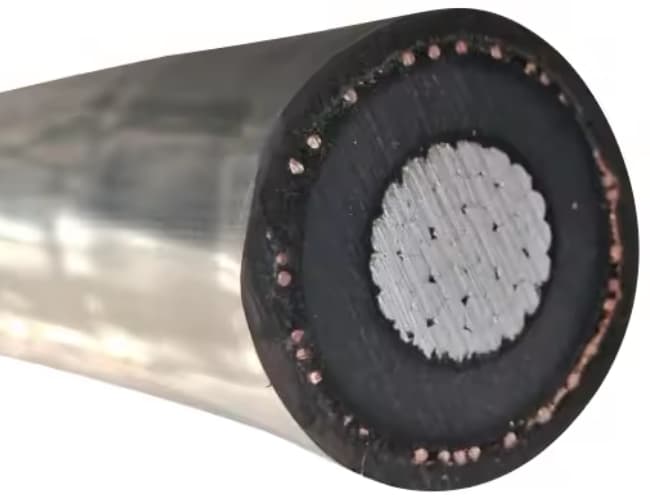
Los medium voltage cables They play an essential role in the distribution of electricity between generation centers and final consumers. These cables are specifically designed to withstand voltages between 1 kV y 36 kV, which makes them a critical component in urban electrical infrastructures, industrial and rural. In this article, We will explore in depth the key aspects of the medium voltage cables, including its types, applications, characteristics, and the different materials used in its manufacture. Besides, we will focus on target keywords, as “underground medium voltage cable”, “medium voltage cable”, and others.
What is a Medium Voltage Cable?
The term medium voltage cables refers to a type of cable used for the transmission of electricity at voltages that vary between 1 kV y 36 kV. These cables are common in electrical distribution systems, where they are used to transport electricity from substations to consumption areas such as industries, commercial businesses and residential areas.
The main difference between low voltage cables and medium voltage cables is the ability to withstand higher voltage levels.. Besides, los medium voltage cables They usually have a more robust construction, since they must be prepared to withstand difficult environmental conditions and, often, be buried underground or strung on overhead lines.
Types of Medium Voltage Cables
There are several types of medium voltage cables, each designed to meet specific requirements. The main types are:
- Underground Medium Voltage Cable: This type of cable is designed to be buried underground, often in urban or industrial environments where overhead lines are not viable. These cables are covered with insulating materials that protect them from moisture., corrosion and other soil elements.
- Overhead Medium Voltage Cable: These cables are used in distribution lines that are placed on poles., usually in rural or suburban areas. Los overhead medium voltage cables are designed to withstand direct exposure to the weather, including strong winds, rain, and temperature fluctuations.
- Aluminum Cables for Low Voltage: Although they are not strictly medium voltage cables, Low voltage aluminum cables play an important role in electrical infrastructure. They are lighter and cheaper compared to copper cables, making them a popular choice in lower voltage applications, such as residential distribution.
- Aluminum Cable for Medium Voltage: This type of cable is mainly used in medium voltage applications. Aluminum is a lighter conductive material than copper and is more economical, but requires larger cable diameters to offer the same conductive capacity.
Characteristics of Medium Voltage Cables
Los medium voltage cables They have a series of technical and constructive characteristics that make them suitable for their purpose.. Next, Some of the most relevant characteristics are detailed:
- Isolation: Insulation is one of the most important aspects of medium voltage cables. Common insulation materials include XLPE (cross-linked polyethylene) and the EPR (ethylene-propylene rubber), offering excellent temperature resistance, humidity and corrosion.
- Armor: Medium voltage cables are usually shielded with a metal layer, which helps protect them against electromagnetic interference and ensures they can withstand mechanical stress in underground or overhead installations.
- Exterior Protection: The outer sheath of medium voltage cables is designed to be resistant to abrasion, humidity, chemicals and temperature fluctuations. Common materials include PVC (polyvinyl chloride) and other specialized plastic compounds.
Applications of Medium Voltage Cables
Los medium voltage cables are used in a wide range of applications, depending on the needs of the project and the environment in which they are installed. Some of the most common applications include:
- Underground Distribution Systems: In urban environments, los underground medium voltage cables They are essential to maintain aesthetics and minimize interference with other infrastructure. These cables are protected from the elements and help reduce the risk of accidents from direct contact with power lines.
- Overhead Distribution Lines: In rural areas, Medium voltage cables are often installed on overhead lines due to ease of installation and lower cost compared to underground installations.
- Industries and Power Plants: Industrial facilities and power plants often rely on medium voltage cables to transport large amounts of electricity from substations to points of final consumption..
- Substations and Electrical Networks: Electrical substations use medium voltage cables to connect different components of the electrical system and ensure efficient energy distribution.

Cable Media Tension 15 kV
One of the most common types of medium voltage cables is he cable media tension 15 kV. This cable is widely used in distribution applications where efficient transportation of electricity over a considerable distance is required.. The cables of 15 kV are used in both underground and overhead installations and are designed to provide reliable performance in harsh conditions.
This type of cable usually has a robust construction with XLPE insulation, Metal shielding and a weather-resistant outer shell. Besides, It is suitable for applications in industrial and urban environments, where intermediate voltage capability is required.
Medium Voltage Underground Cables
The use of medium voltage underground cables has increased in recent years due to the need to reduce the visual impact of overhead lines and improve electrical safety in densely populated areas. These cables are designed to be buried in trenches and protected from external damage by layers of insulation and shielding..
Underground cables offer several advantages, such as reducing the risk of supply interruptions due to adverse weather conditions, improving security and minimizing electromagnetic interference. However, They also present some challenges, such as higher installation costs and difficulties in maintenance and repair.
Advantages and Disadvantages of Medium Voltage Cables
Like any other electrical infrastructure component, los medium voltage cables They have both advantages and disadvantages. Next, Some key points are presented:
Advantages:
- High energy transport capacity: Medium voltage cables are capable of carrying large amounts of electricity over longer distances compared to low voltage cables..
- Installation flexibility: They can be installed in both overhead and underground lines, allowing great versatility in electricity distribution projects.
- Security and reliability: Medium voltage cables are designed to withstand extreme environmental conditions, making them a safe and reliable option for various applications.
Disadvantages:
- Higher costs: Compared to low voltage cables, Medium voltage cables tend to be more expensive both in terms of materials and installation.
- Complicated maintenance: Underground medium voltage cables can be difficult to repair and maintain, often requiring excavation and significant downtime.
Factors to Consider When Choosing Medium Voltage Cables
Choose the medium voltage cable suitable for a specific project requires careful consideration of several factors, including:
- Nominal Voltage: Be sure to select a cable that is suitable for the voltage level of your application. Medium voltage cables are available in various voltage ranges, including common options like 10 kV, 15 kV, y 20 kV.
- Installation Environment: Consider whether the cable will be installed in an underground or aerial environment, and choose a cable with the appropriate insulation and protection characteristics for that environment.
- Driver Material: Decide if you will use aluminum cables o copper cables. Aluminum is lighter and cheaper, while copper offers better electrical conductivity.
- Local Regulations: Make sure cables comply with local regulations and safety standards, especially in public or industrial infrastructure projects.
Medium Voltage Cables Conclusion
Los medium voltage cables They are a crucial part of modern electrical infrastructures, and their correct selection and installation are essential to guarantee efficient and safe distribution of electricity. Whether you are looking for underground medium voltage cables o overhead medium voltage cables, It is important to consider factors such as voltage, installation environment and driver materials to ensure the success of your project.
This article has provided a comprehensive view on the medium voltage cables, its characteristics, applications and factors.
